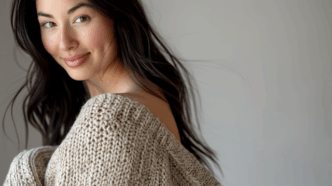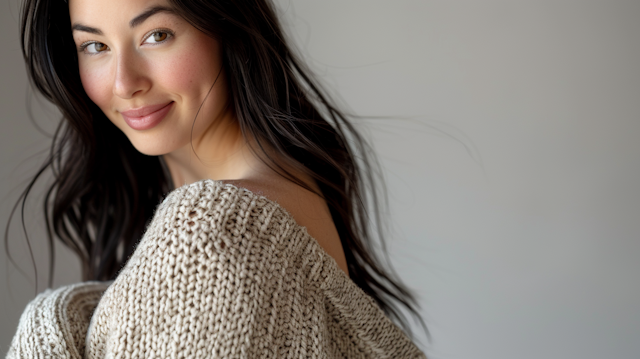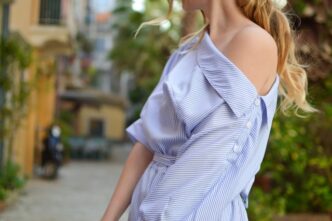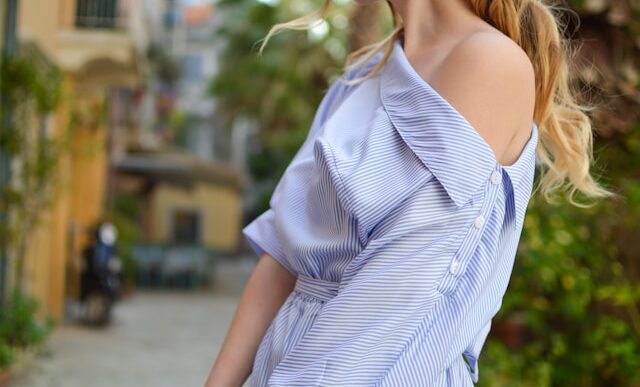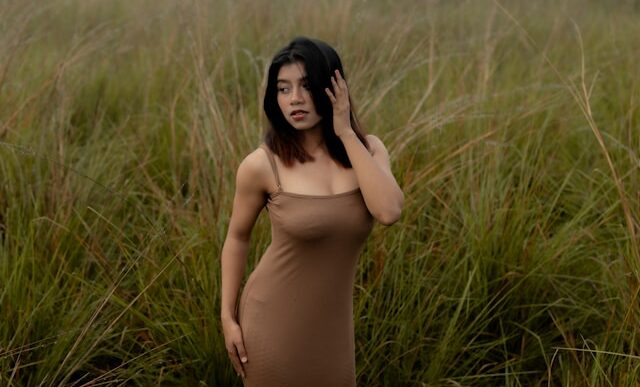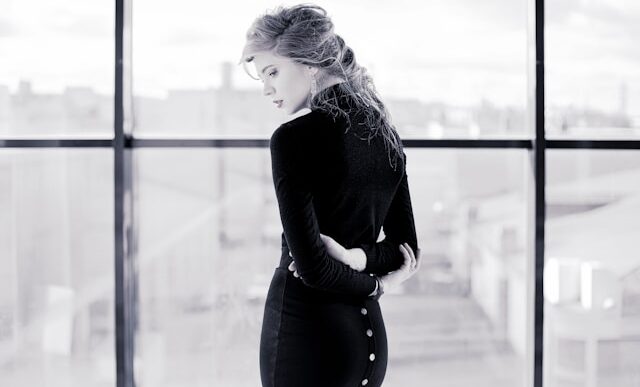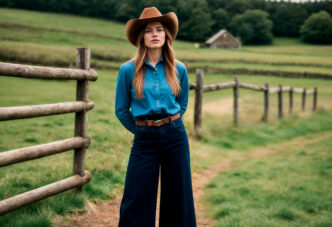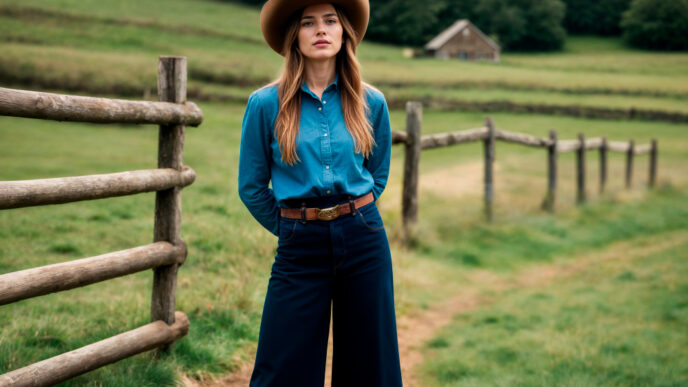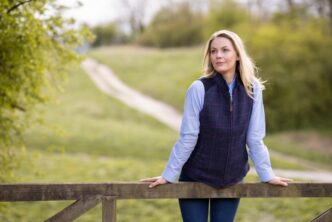The tweed dress stands as fashion’s most enduring symbol of refined sophistication, bridging the gap between Parisian chic and British heritage with effortless elegance. Understanding how to style tweed dress for women unlocks a world of sartorial possibilities that span from boardroom authority to weekend sophistication. This iconic fabric, with its rich history rooted in Scottish highlands and elevated by Coco Chanel’s revolutionary vision, continues to captivate contemporary fashion enthusiasts who appreciate its timeless appeal and remarkable versatility. From Virginie Viard’s modern interpretations at Chanel to emerging designers who reimagine tweed’s potential, this fabric represents more than mere textile—it embodies a philosophy of enduring style over fleeting trends. This comprehensive guide explores the nuanced art of incorporating tweed dresses into modern wardrobes, offering strategic insights into silhouette selection, color coordination, and the subtle details that elevate these sophisticated pieces from classic to contemporary. Whether you’re drawn to structured blazer dresses or fluid A-line silhouettes, mastering these styling principles ensures your tweed dress becomes a cornerstone of effortless elegance.
Top 10 Tweed Dress Outfit Ideas
The artistry of tweed dress outfit for women lies in their remarkable ability to oscillate between professional authority and social sophistication while maintaining the inherent elegance that defines this legendary fabric. These carefully curated combinations demonstrate how women’s tweed dress outfits can serve various style narratives while honoring tweed’s rich heritage and contemporary relevance. Each pairing explores different facets of modern dressing, from minimalist precision to maximalist expression.
Tweed Dress with Pearl Jewelry
This quintessentially elegant combination pays homage to Coco Chanel’s revolutionary vision while maintaining contemporary relevance and timeless sophistication. The pairing represents fashion’s most enduring marriage of texture and luster, where tweed’s matte complexity provides perfect backdrop for pearls’ luminous simplicity. This styling approach channels the refined aesthetics of brands like Chanel and Mikimoto, where traditional luxury elements create modern elegance through thoughtful coordination and impeccable craftsmanship.
The success of this combination lies in understanding scale relationships and achieving balanced sophistication. Classic pearl strands work beautifully with structured tweed dresses, creating elegant neckline framing that enhances both the fabric’s texture and the pearls’ lustrous quality. Consider varying pearl sizes and lengths for added visual interest—layered strands create depth and movement, while single statement pieces provide clean, architectural elegance. Modern interpretations might include baroque pearls for organic appeal or contemporary settings that bridge traditional and avant-garde aesthetics.
Color coordination within this pairing offers numerous sophisticated possibilities. Traditional cream or white pearls work universally well with any tweed color, providing classic elegance that never appears dated or overly trendy. Colored pearls—soft grays, champagne hues, or even black varieties—create more contemporary appeal while maintaining the combination’s inherent sophistication. The key lies in ensuring the pearls enhance rather than compete with the tweed’s natural complexity and visual weight.
Complete the styling with accessories that honor both elements’ luxury status. Choose handbags in structured leather or quilted materials that echo tweed’s textural richness, and select footwear in classic silhouettes—pointed-toe pumps, elegant loafers, or refined ankle boots that maintain the look’s sophisticated foundation. This combination works across numerous occasions, from professional presentations to cultural events, making it invaluable for women who appreciate timeless elegance with contemporary relevance.
Tweed Dress with Turtleneck Layering
This sophisticated layering approach demonstrates contemporary styling techniques while honoring tweed’s heritage through thoughtful proportion play and textural contrast. The combination channels the innovative layering approaches seen in brands like COS and Toteme, where architectural thinking meets wearable sophistication. The turtleneck provides elegant coverage and modern silhouette definition while allowing the tweed dress to serve as the primary style statement.
The turtleneck selection significantly impacts both aesthetic success and comfort levels throughout wear. Fine-gauge knits in cashmere or merino wool provide luxurious feel that complements tweed’s premium status while maintaining sleek, body-conscious silhouettes that prevent bulk or unflattering proportions. Consider colors that create either tonal harmony or strategic contrast—cream turtlenecks with gray tweed create sophisticated monochromatic elegance, while black pieces with colored tweed offer striking, graphic appeal.
Silhouette considerations require careful attention to both pieces’ proportions and your natural body lines. Fitted turtlenecks work beautifully under structured tweed dresses, creating smooth, uninterrupted lines that flatter various body types while maintaining professional appropriateness. The dress’s neckline should accommodate the turtleneck comfortably—crew necks and boat necks work particularly well, while high necklines might compete or create unflattering bulk around the throat area.
This layering technique extends the tweed dress’s seasonal versatility significantly, making it appropriate for cooler months while maintaining sophisticated appeal. Choose accessories that complement both pieces’ refined aesthetic—structured handbags, refined footwear, and minimal jewelry that doesn’t compete with the layering’s inherent visual interest. This approach works particularly well in professional environments where elevated casual dressing is appreciated and appropriate.
Tweed Dress with Statement Coat
The pairing of tweed dresses with dramatic outerwear creates compelling fashion moments that demonstrate advanced styling sensibilities and sophisticated understanding of proportion relationships. This combination draws inspiration from European fashion capitals where layering serves both practical and aesthetic purposes, creating memorable looks that photograph beautifully while providing necessary weather protection. The coat serves as the outfit’s architectural element while the tweed dress provides sophisticated foundation.
Coat selection requires balancing drama with practicality while ensuring both pieces enhance rather than compete with each other. Wool coats in complementary colors create rich, textural landscapes—camel coats with navy tweed, or cream pieces with gray dresses establish sophisticated earth-tone palettes. For more dramatic impact, consider coats in contrasting colors or interesting textures that create visual tension while maintaining overall harmony. Length relationships matter tremendously; longer coats work well with shorter tweed dresses, while cropped styles complement midi or longer dress lengths elegantly.
The styling approach should emphasize both pieces’ strengths while creating cohesive, intentional proportions. Leave coats open to reveal the tweed dress’s silhouette and details, or button strategically to create interesting line breaks and visual interest. Consider the coat’s closure style—double-breasted options add structured formality, while single-breasted styles offer more relaxed sophistication. Belt options can define the waist and create flattering proportions that work with various body types.
Accessories should complement both pieces without overwhelming the combination’s inherent drama. Choose handbags that coordinate with either the coat or dress color, and select footwear that provides proportional balance—ankle boots for contemporary edge, knee-high styles for sophisticated coverage, or classic pumps for timeless elegance. This approach works particularly well for special occasions, cultural events, or professional settings where making memorable first impressions matters significantly.
Tweed Dress with Leather Accessories
This combination demonstrates fashion’s ongoing love affair with mixed textures, where tweed’s organic complexity meets leather’s sleek sophistication to create looks that feel both heritage-inspired and thoroughly contemporary. The pairing channels the refined aesthetics of brands like Hermès and Bottega Veneta, where material quality and craftsmanship take precedence over obvious trends or seasonal whims. The contrast between textures creates visual interest while maintaining sophisticated elegance appropriate for numerous occasions.
Leather selection requires understanding both color relationships and accessory proportions that will enhance rather than overwhelm the tweed dress’s inherent sophistication. Classic brown leather creates rich, organic combinations that feel timeless and versatile—cognac handbags, tan belts, or chestnut boots establish warm, earth-inspired palettes that work across seasons. Black leather offers sleek, graphic contrast that works particularly well with lighter tweed colors, creating striking combinations perfect for urban professional environments or evening social events.
The accessory approach should create cohesive styling that feels intentional rather than coincidental. Consider coordinating multiple leather pieces in the same color family—matching handbag and shoes, or belt and gloves that create unified visual impact. However, avoid complete matching, which can appear overly coordinated or dated. Instead, choose pieces in similar but not identical tones that create depth and visual interest while maintaining sophisticated harmony.
Quality considerations become paramount when combining premium tweed with leather accessories. Investment leather pieces with superior construction and materials justify their pairing with quality tweed dresses while providing longevity that matches the dress’s timeless appeal. Consider classic shapes and styles that won’t date quickly—structured handbags, classic pump silhouettes, or refined belt designs that enhance rather than distract from the tweed’s natural beauty and texture complexity.
Tweed Dress with Silk Scarf
This pairing represents fashion’s most sophisticated approach to accessory integration, where silk scarves serve both functional and aesthetic purposes while enhancing tweed dresses’ inherent elegance. The combination draws inspiration from European styling traditions where scarves are essential wardrobe tools rather than optional embellishments. The silk’s lustrous surface creates compelling contrast against tweed’s matte texture, while both pieces share common vocabulary of luxury craftsmanship and timeless appeal.
Scarf selection requires understanding both color relationships and pattern scales that will complement rather than compete with tweed’s natural complexity. Solid colors in jewel tones create rich, sophisticated combinations—emerald silk with gray tweed, or burgundy pieces with cream dresses establish elegant color stories that feel both classic and contemporary. Printed scarves require more careful consideration; choose patterns with appropriate scale and color intensity that enhance rather than overwhelm the tweed’s inherent visual weight.
The styling technique significantly impacts both aesthetic success and practical functionality. Classic neck ties create elegant, feminine touches that work particularly well with crew neck or boat neck tweed dresses. French knots add sophisticated European flair while providing subtle color and texture interest near the face. For more contemporary approaches, consider draping scarves over shoulders or using them as belt alternatives that define the waist while adding unexpected styling details.
Seasonal considerations extend this combination’s versatility significantly. Lightweight silk scarves work beautifully for spring and summer styling, providing color interest without overwhelming warmth. Heavier silk varieties or silk-wool blends offer transitional season functionality while maintaining the combination’s inherent elegance. Choose scarf sizes appropriate for your intended styling approach—larger squares offer more versatility, while smaller neckerchiefs provide subtle accent opportunities that enhance without overwhelming the tweed dress’s sophisticated foundation.
Tweed Dress with Modern Sneakers
This high-low combination represents contemporary fashion’s democratic approach to luxury dressing, where premium tweed dresses pair effortlessly with athletic-inspired footwear to create looks that feel both accessible and sophisticated. The contrast demonstrates advanced styling confidence while appealing to modern women who appreciate comfort without sacrificing style credentials. This pairing channels the innovative approaches seen in brands like Ganni and Cecilie Bahnsen, where unexpected combinations create memorable, conversation-starting looks.
Sneaker selection requires balancing athletic functionality with aesthetic sophistication that won’t diminish the tweed dress’s inherent elegance. Clean, minimalist designs in white or neutral colors work universally well, providing contemporary edge without overwhelming the combination’s sophisticated foundation. Avoid overly technical or bold designs that might create jarring contrasts or compete with the tweed’s natural visual weight. Premium sneaker brands often offer elevated options with superior materials and construction that better complement luxury tweed pieces.
The tweed dress style should complement this casual footwear choice while maintaining overall sophistication and intentional styling. Structured A-line or fit-and-flare dresses work particularly well, creating playful proportions that embrace the combination’s high-low nature. Avoid overly formal or severe dress styles that might create uncomfortable contrast with casual footwear. The dress length should work harmoniously with sneakers—midi lengths often provide ideal proportions that feel balanced and contemporary.
Color coordination requires thoughtful consideration to ensure both pieces feel intentionally paired rather than accidentally combined. Neutral sneakers work with virtually any tweed color, while colored options require careful coordination with the dress’s hues. Consider how accessories will bridge both elements—casual handbags, minimal jewelry, and relaxed styling approaches that embrace the combination’s contemporary, approachable aesthetic while maintaining sophisticated appeal appropriate for creative professional environments or casual social gatherings.
Tweed Dress with Knee-High Boots
This combination creates dramatic, sophisticated silhouettes that work particularly well during cooler months while demonstrating advanced understanding of proportion relationships and seasonal styling. The boots provide elegant coverage and contemporary edge while the tweed dress maintains sophisticated femininity, creating looks that work across professional and social contexts. This pairing draws inspiration from European fashion capitals where practical considerations merge seamlessly with aesthetic sophistication.
Boot selection significantly impacts both comfort and visual success, requiring attention to heel height, shaft width, and overall proportions relative to both your body type and the dress’s silhouette. Classic leather boots in black, brown, or neutral tones create versatile foundations that work with numerous tweed colors and patterns. Consider heel heights that provide comfort for extended wear while maintaining elegant proportions—moderate heels often offer ideal balance between sophistication and practicality for daily activities.
The dress length becomes crucial in this pairing, as it determines the visual relationship between hemline and boot shaft that can either create flattering proportions or awkward styling gaps. Mini and above-knee tweed dresses work beautifully with knee-high boots, creating seamless leg lines that elongate the silhouette while providing sophisticated coverage. Avoid lengths that create awkward breaks or visual interruptions that compromise the combination’s elegant flow.
Styling details can elevate this combination from good to exceptional. Consider how the dress’s silhouette works with the boots’ structure—fitted dresses create sleek, sophisticated lines, while A-line styles provide feminine contrast to the boots’ structured appearance. Accessories should complement both pieces’ sophisticated aesthetic—structured handbags, refined outerwear, and jewelry that enhances rather than competes with the combination’s inherent drama and visual interest.
Tweed Dress with Blazer Layering
This powerful combination creates authoritative, professional looks that demonstrate sophisticated understanding of formal dressing while maintaining contemporary relevance and personal style expression. The blazer adds structured sophistication while the tweed dress provides textural interest and feminine appeal, creating outfits suitable for high-level professional environments, formal social events, or occasions where making strong first impressions matters significantly.
Blazer selection requires careful attention to both fit and fabric relationships that will complement rather than compete with the tweed dress’s inherent structure and visual weight. Choose blazers in fabrics that provide interesting contrast—smooth wool gabardine against tweed’s textured surface, or subtle patterns that add visual interest without overwhelming the combination. Consider color relationships carefully; tonal approaches create sophisticated, monochromatic elegance, while contrasting colors provide more dynamic visual appeal.
The layering technique should emphasize both pieces’ strengths while creating flattering proportions appropriate for your body type and professional requirements. Leave blazers open to reveal the tweed dress’s details and silhouette, or button strategically to create interesting line breaks and waist definition. Consider how the blazer’s length works with the dress—shorter blazers work well with longer dresses, while longer styles complement shorter dress lengths elegantly.
Professional appropriateness becomes paramount in this combination, requiring understanding of workplace dress codes and industry expectations while maintaining personal style expression. This pairing works particularly well in creative industries, consulting environments, or professional settings where sophisticated dressing is expected and appreciated. Complete the styling with accessories that enhance the combination’s authoritative aesthetic—structured handbags, classic pumps, and refined jewelry that supports rather than distracts from the powerful professional image this combination creates.
Tweed Dress with Statement Handbag
This accessory-focused approach demonstrates how strategic styling choices can transform classic tweed dresses into contemporary fashion statements while showcasing personal style preferences and current trend awareness. The handbag serves as the outfit’s focal point, creating visual interest and personality expression while the tweed dress provides sophisticated foundation that grounds more adventurous accessory choices.
Handbag selection requires balancing statement-making potential with practical functionality while ensuring the piece enhances rather than overwhelms the tweed dress’s inherent elegance. Consider bags with interesting shapes, textures, or colors that create compelling contrast against tweed’s traditional appearance. Structured geometric shapes work particularly well, providing contemporary edge that feels intentional rather than accidental. Avoid bags that compete too aggressively with tweed’s natural complexity or visual weight.
Color relationships within this combination offer extensive creative possibilities while requiring thoughtful coordination to maintain sophisticated appeal. Neutral tweed dresses provide excellent foundations for bold handbag colors—emerald bags with gray dresses, or coral pieces with cream tweed create striking, memorable combinations. When working with colored tweed, choose handbags in complementary or tonal relationships that enhance rather than compete with the dress’s hues.
The overall styling approach should support the handbag’s statement-making role while maintaining balanced proportions and sophisticated appeal. Keep other accessories minimal to allow the bag’s impact to shine through clearly, and choose footwear and jewelry that complement rather than compete with the handbag’s presence. This approach works particularly well for social events, creative professional environments, or occasions where personal style expression is appreciated and encouraged while maintaining sophisticated elegance.
Tweed Dress with Delicate Gold Jewelry
This refined combination celebrates understated luxury and timeless elegance, creating sophisticated looks that work across numerous occasions while demonstrating appreciation for quality craftsmanship and enduring style principles. The delicate gold jewelry enhances tweed’s natural richness without overwhelming its textural complexity, creating harmonious combinations that feel both classic and contemporary.
Jewelry selection requires understanding scale relationships and metal tones that will complement tweed’s natural colors and textures while providing appropriate visual impact. Fine gold chains, subtle earrings, and classic watch designs work beautifully with tweed’s sophisticated aesthetic, providing refined accents that enhance rather than compete with the fabric’s inherent beauty. Consider layering delicate pieces for added interest—multiple thin chains or stacked rings create contemporary appeal while maintaining elegance.
Metal tone considerations become important when coordinating gold jewelry with tweed’s often complex color palettes. Yellow gold works beautifully with warm tweed tones—browns, creams, and earth-inspired colors that create rich, harmonious combinations. Rose gold offers contemporary appeal while maintaining warmth that complements most tweed colors elegantly. White gold or platinum might work better with cooler tweed tones, though the warmth of yellow and rose gold generally provides more flattering and harmonious relationships.
The overall aesthetic should emphasize refined simplicity and quality over quantity, allowing both the tweed dress and jewelry to shine through their individual merits while creating cohesive, sophisticated combinations. This approach works particularly well for professional environments, cultural events, or social occasions where understated elegance and attention to detail are appreciated and appropriate.
Types and Styles of Tweed Dress
Understanding the diverse landscape of types of tweed dress for women enables strategic wardrobe building while ensuring selections align with personal style preferences, professional requirements, and lifestyle considerations. The category encompasses numerous silhouettes, constructions, and interpretations, each offering distinct aesthetic qualities and wearing opportunities that cater to different fashion sensibilities and practical needs.
Classic Chanel-Inspired Dresses represent the category’s most iconic interpretation, featuring the structured elegance and timeless proportions that revolutionized women’s fashion in the 1920s and continue influencing contemporary design. These dresses typically showcase boxy, architectural silhouettes with clean lines, strategic seaming, and minimal embellishment that allows the tweed fabric to serve as the primary design element. The construction often includes features like braided trim, functional pockets, and chain-weighted hems that reflect Chanel’s attention to both aesthetic beauty and practical functionality. Modern interpretations by designers like Virginie Viard maintain these essential elements while incorporating contemporary fits and proportions that appeal to current fashion sensibilities.
A-Line and Fit-and-Flare Silhouettes offer universally flattering alternatives that work across body types while maintaining tweed’s sophisticated appeal. These styles typically feature fitted bodices that transition into flowing skirts, creating feminine proportions that balance structure with movement. The A-line construction particularly flatters pear-shaped figures while providing comfortable wear and elegant appearance across various occasions. Contemporary designers often incorporate modern details like strategic cutouts, interesting necklines, or unexpected color combinations that update traditional silhouettes for current fashion landscapes.
Shift and Straight-Cut Dresses provide minimalist sophistication perfect for professional environments and formal occasions where clean, uncluttered lines create authoritative presence. These styles emphasize tweed’s natural texture and color complexity while maintaining comfortable, easy-wearing proportions that work well for extended periods. The straight silhouette particularly appeals to those who prefer less fitted clothing while maintaining sophisticated appearance and professional appropriateness.
Blazer-Style Dresses bridge the gap between tailored suiting and feminine dressing, offering structured sophistication that works particularly well in professional contexts. These designs often incorporate elements like lapels, button closures, and pocket details that reference menswear traditions while maintaining distinctly feminine proportions and appeal. The blazer dress format works exceptionally well for women who need versatile pieces that transition seamlessly between professional and social contexts.
Contemporary Designer Interpretations reflect current fashion trends while honoring tweed’s traditional heritage through innovative approaches to cut, color, and construction. Brands like Acne Studios offer oversized, avant-garde interpretations that challenge traditional proportions, while houses like Erdem incorporate romantic details like lace inserts or floral embroidery that create unexpected textural contrasts. These contemporary approaches appeal to fashion-forward individuals who appreciate tradition but desire pieces that feel current and relevant to contemporary style landscapes.
Seasonal Variations address different climate needs and aesthetic preferences throughout the year. Lightweight tweed versions in cotton or linen blends provide breathable comfort for spring and summer wear while maintaining the fabric’s characteristic texture and visual appeal. Traditional wool tweeds offer warmth and structure perfect for fall and winter styling, with weights ranging from moderate business-appropriate options to substantial pieces suitable for colder climates. Luxury interpretations might include cashmere-blend tweeds or silk-touched varieties that provide superior comfort and drape while justifying investment pricing through exceptional quality and construction.
Color and Pattern Variations significantly impact styling possibilities and aesthetic outcomes. Classic neutral tweeds in gray, navy, black, or cream provide maximum versatility and coordinate seamlessly with existing wardrobe pieces. Earth-toned options in browns, olives, or muted greens create rich, organic palettes perfect for fall styling and natural fiber combinations. Contemporary colors might include pastels, brights, or unexpected hues that reflect current color trends while maintaining tweed’s sophisticated appeal. Pattern variations range from subtle heathered effects to bold plaid or houndstooth designs that create statement-making appeal.
Construction Quality Indicators vary significantly across price points and brands, making quality assessment crucial for investment decisions. Superior tweed dresses feature details like French seams that prevent fraying and provide clean interior finishing, quality linings that enhance comfort and prevent transparency, well-constructed closures including zippers, buttons, or hooks that function smoothly and maintain their appearance over time, and proper interfacing that maintains structure and shape through repeated wear and cleaning. Hand-finished details like bound buttonholes or hand-sewn trim indicate superior craftsmanship that justifies premium pricing and provides exceptional longevity.
Understanding these various styles of tweed dress enables informed shopping decisions while ensuring selected pieces align with personal style preferences, professional requirements, and long-term wardrobe goals, providing maximum versatility and styling satisfaction across seasons and occasions.
How To Choose The Best Tweed Dress
Selecting the perfect tweed dress requires systematic evaluation of multiple factors that impact both immediate satisfaction and long-term wardrobe value, ensuring investments align with personal style preferences, lifestyle requirements, and quality expectations while providing maximum versatility and professional appropriateness.
Step 1: Assess Your Professional and Social Requirements Begin by honestly evaluating where and how you’ll wear the tweed dress most frequently. Consider your workplace dress code—conservative corporate environments might welcome classic, structured styles in neutral colors, while creative industries often appreciate more contemporary interpretations with interesting details or unexpected colors. Analyze your social calendar and determine whether you need dresses suitable for formal events, casual gatherings, or versatile pieces that adapt across various occasions. Understanding these requirements prevents purchasing pieces that won’t integrate effectively into your lifestyle patterns.
Step 2: Determine Your Optimal Silhouette and Fit Preferences Understanding which dress silhouettes flatter your body type ensures satisfaction and frequent wear while building confidence in your appearance. A-line and fit-and-flare styles work universally well, providing flattering proportions for most figures while offering comfortable wear across extended periods. Straight or shift styles create clean, professional lines but require confidence and appropriate undergarments for optimal appearance. Consider your personal comfort preferences—some women prefer more fitted styles that define their silhouette, while others appreciate looser fits that provide comfortable ease and movement flexibility.
Step 3: Evaluate Fabric Quality and Construction Details Tweed quality varies dramatically across price points, making careful evaluation essential for investment pieces. Examine the fabric’s hand-feel—quality tweed should feel substantial without being heavy, with consistent weaving and smooth, even texture throughout. Check construction details including seam finishing, lining quality, and closure functionality. Look for signs of superior craftsmanship like French seams, quality buttons, smooth-operating zippers, and proper interfacing that maintains structure. These details significantly impact both appearance and longevity, justifying investment in higher-quality pieces.
Step 4: Consider Color and Pattern Versatility Color selection dramatically impacts styling possibilities and wardrobe integration success. Neutral colors like navy, gray, black, or cream offer maximum coordination potential with existing wardrobe pieces while providing sophisticated appeal across seasons and occasions. Bold colors or patterns create statement-making potential but may offer limited styling flexibility and require careful coordination with accessories and layering pieces. Consider your existing wardrobe colors and ensure selected pieces will coordinate well with items you frequently wear and enjoy.
Step 5: Set Realistic Budget Parameters and Research Value Options Determine your budget based on expected wear frequency, quality requirements, and long-term wardrobe goals. Investment pieces from established luxury brands typically offer superior materials, construction, and design details that justify higher pricing through exceptional quality and timeless appeal. However, excellent mid-range options exist that provide good quality and classic styling without luxury price points. Research brand reputations, read customer reviews focusing on fit and durability, and consider cost-per-wear calculations to evaluate true value rather than initial price alone.
Step 6: Plan for Care Requirements and Long-Term Maintenance Tweed dresses often require specific care that impacts both ownership costs and convenience. Review care labels carefully and ensure you’re prepared for maintenance requirements—some pieces require professional dry cleaning, while others might be suitable for gentle home care. Consider storage requirements, as tweed can attract moths and requires proper protection during off-seasons. Factor these ongoing care considerations into your decision-making process to ensure realistic expectations and proper garment maintenance that preserves your investment’s appearance and longevity.
These systematic recommendations ensure you select a tweed dress that provides exceptional satisfaction, versatile styling opportunities, and excellent long-term value while perfectly complementing your individual style preferences, professional requirements, and lifestyle considerations.
Seasonal Style Guide for Tweed Dress
Mastering year-round tweed dress styling requires understanding how to adapt these sophisticated pieces across changing weather conditions, seasonal color palettes, and occasion-appropriate dressing while maintaining their inherent elegance and professional appeal throughout different times of year.
Fall: Tweed’s Natural Season and Heritage Connections Fall represents tweed’s most natural habitat, as the fabric’s origins in Scottish highlands and its association with harvest seasons create perfect harmony with autumn’s aesthetic and practical requirements. This season allows for the most traditional and authentic tweed styling approaches while embracing the rich color palettes and textural layering that define sophisticated fall dressing. The moderate temperatures provide ideal conditions for tweed’s medium weight and structured construction without overwhelming warmth or discomfort.
Choose tweed dresses in classic fall colors—rich burgundies, deep forest greens, warm browns, or sophisticated grays that echo autumn’s natural palette while providing versatile coordination with seasonal accessories and outerwear. Layer with cashmere cardigans or wool blazers for professional environments, and consider textural combinations that highlight fall’s material richness—tweed with suede, leather, or other organic textures that create sophisticated depth and visual interest.
Fall accessories should complement tweed’s traditional heritage while maintaining contemporary relevance. Leather boots in cognac, brown, or black provide sophisticated support and weather protection while enhancing tweed’s natural earth-toned aesthetic. Structured handbags in complementary leather tones create cohesive, professional appearances suitable for business environments and formal social occasions. Scarves in wool, cashmere, or silk add both warmth and styling interest while providing color coordination opportunities that enhance the overall sophisticated appeal.
Winter: Elevated Layering and Sophisticated Warmth Winter tweed styling focuses on strategic layering that maintains elegance while providing necessary warmth and weather protection. The season’s colder temperatures make tweed dresses ideal for heated indoor environments while requiring thoughtful outerwear selections that complement rather than hide the dress’s sophisticated details and tailored construction.
Layer tweed dresses over turtlenecks, fitted sweaters, or silk blouses for added warmth that maintains professional appropriateness and sophisticated appearance. Choose layering pieces in neutral colors that won’t compete with the tweed’s pattern or texture complexity while providing necessary coverage and comfort. Consider tights or hosiery in coordinating colors that extend the dress’s versatility while providing leg warmth and professional coverage appropriate for formal business environments.
Winter outerwear becomes crucial for both protection and style completion. Choose coats in complementary colors and luxurious materials—wool, cashmere, or high-quality synthetic blends that provide weather protection while maintaining sophisticated appearance. Longer coats work particularly well with shorter tweed dresses, while cropped styles complement longer dress lengths elegantly. Consider fur or faux fur accents that add textural richness and seasonal appropriateness while maintaining ethical considerations and personal preferences.
Spring: Contemporary Interpretations and Fresh Approaches Spring tweed styling requires balancing the fabric’s traditional weight and associations with the season’s lighter aesthetic and optimistic energy. This season provides opportunities for contemporary interpretations that honor tweed’s heritage while embracing current fashion trends and fresh color palettes that feel appropriate for seasonal renewal and professional advancement.
Choose lighter-weight tweeds or tweed-inspired fabrics that provide the aesthetic appeal without overwhelming warmth inappropriate for spring temperatures. Consider tweed dresses in updated colors—soft pastels, fresh whites, or contemporary patterns that reflect spring’s optimistic energy while maintaining professional sophistication. Layer with lightweight cardigans, cropped blazers, or structured jackets that provide versatility for variable spring weather while maintaining polished appearance.
Spring accessories should reflect the season’s fresh energy while complementing tweed’s inherent sophistication. Choose footwear in lighter colors or contemporary styles—nude pumps, metallic flats, or modern sneakers that bridge traditional and contemporary aesthetics. Handbags in structured styles and fresh colors provide seasonal update opportunities while maintaining professional appropriateness and coordination with the tweed’s sophisticated foundation.
Summer: Unexpected Elegance and Climate Adaptation Summer tweed styling presents unique challenges and opportunities, requiring careful selection of lightweight interpretations and strategic styling that maintains sophistication while addressing warm weather comfort requirements. This season demands creativity and understanding of fabric variations that provide tweed’s aesthetic appeal without inappropriate warmth or discomfort.
Choose summer-appropriate tweed interpretations—cotton-linen blends, lightweight constructions, or tweed-inspired patterns in breathable fabrics that provide the visual appeal without traditional wool’s warmth and weight. Consider sleeveless or short-sleeve tweed dresses that reduce coverage while maintaining sophisticated silhouettes appropriate for professional air-conditioned environments and formal summer events.
Summer styling should emphasize breathability and comfort while maintaining tweed’s inherent elegance and professional appeal. Choose accessories in lighter colors and breathable materials—canvas or lightweight leather shoes, structured handbags in fresh colors, and minimal jewelry that won’t add overwhelming warmth or visual weight. Consider how indoor air conditioning affects comfort and styling needs, ensuring pieces work well in climate-controlled professional environments while remaining appropriate for outdoor transitional periods.
Do’s and Don’ts of Wearing Tweed Dress
Understanding the fundamental principles of tweed dress styling prevents common mistakes while maximizing these sophisticated pieces’ fashion potential and professional appropriateness. These essential guidelines ensure you always present polished, authoritative looks that honor tweed’s heritage while embracing contemporary styling approaches and personal expression.
Essential Do’s for Tweed Dress Excellence
Do invest in quality construction and authentic materials. Genuine tweed dresses made from quality wool, properly woven and constructed with attention to traditional craftsmanship techniques, provide superior appearance, longevity, and styling success compared to synthetic imitations or poorly constructed alternatives. Quality tweed maintains its structure, color, and texture through multiple wears and cleanings while providing the sophisticated drape and appearance that justifies investment pricing. Look for construction details like French seams, quality linings, and superior closure mechanisms that indicate authentic craftsmanship and long-term value.
Do understand proportion relationships and silhouette balance. Tweed dresses possess natural structure and visual weight that requires thoughtful coordination with accessories, layering pieces, and footwear to create flattering, intentional proportions. Balance structured tweed with softer accessories like silk scarves or delicate jewelry that provide textural contrast without competing for visual attention. Consider your body type when selecting silhouettes—A-line styles work universally well, while fitted options require confidence and appropriate undergarments for optimal appearance and comfort.
Do respect the fabric’s professional heritage and appropriate contexts. Tweed dresses excel in professional environments, formal social occasions, and situations where sophisticated, authoritative appearance matters significantly. Understanding when and where to wear tweed prevents style missteps while maximizing the fabric’s inherent advantages in creating credible, polished presentations. Choose styling approaches that honor tweed’s traditional associations while incorporating contemporary elements that feel current and personally relevant.
Do pay attention to seasonal appropriateness and weather considerations. While tweed works across seasons with proper styling, understanding fabric weights and seasonal coordination principles ensures comfort and appropriate appearance. Traditional wool tweeds work best in cooler months, while lighter interpretations or strategic styling can extend wear into warmer seasons. Consider climate control in professional environments and how tweed’s inherent warmth affects comfort throughout extended wear periods.
Do coordinate colors thoughtfully and strategically. Tweed’s often complex color combinations require careful coordination with accessories, layering pieces, and makeup choices to create harmonious, sophisticated looks. Neutral accessories work universally well with most tweed colors, while bold accent pieces require careful consideration to ensure enhancement rather than competition. Understanding color theory and personal coloring helps create flattering combinations that complement both the tweed and your natural features.
Critical Don’ts to Avoid
Don’t overwhelm tweed’s natural sophistication with excessive embellishment or competing elements. Tweed possesses inherent visual interest through texture, pattern, and construction that doesn’t require additional ornamentation or busy accessories. Avoid overwhelming jewelry, bold patterns, or competing textures that fight for attention with the tweed’s natural complexity. Instead, choose accessories that complement and enhance the fabric’s sophisticated appeal while maintaining clean, intentional styling that feels polished rather than overdone.
Don’t ignore proper care and maintenance requirements. Tweed requires specific care to maintain its appearance, structure, and longevity—neglecting these requirements can result in permanent damage, premature wear, or loss of the sophisticated appearance that justifies investment in quality pieces. Follow manufacturer care instructions precisely, store pieces properly to prevent moth damage or shape distortion, and address stains or damage immediately with appropriate professional treatment. Proper storage with cedar blocks or lavender sachets prevents moth damage, while padded hangers maintain structure and prevent unwanted creasing.
Don’t attempt inappropriate styling combinations that diminish tweed’s inherent elegance. Certain casual pieces or overly trendy accessories may clash with tweed’s sophisticated heritage and professional associations, creating confused styling messages that appear poorly planned or inappropriate for the occasion. Avoid pairing quality tweed dresses with obviously cheap accessories, extremely casual footwear, or pieces that create jarring style contrasts. While contemporary styling can update traditional pieces, ensure combinations feel intentional and sophisticated rather than accidental or mismatched.
Don’t overlook fit and proportion considerations specific to your body type. Tweed’s structured nature requires proper fit to achieve flattering, professional appearance—poorly fitted pieces can appear boxy, unflattering, or unprofessional regardless of fabric quality or construction excellence. Ensure proper shoulder fit, appropriate length for your proportions, and comfortable ease through the body that allows natural movement without pulling or gapping. Consider professional alterations for investment pieces to achieve optimal fit and proportions that enhance rather than detract from your natural silhouette.
Don’t limit tweed to overly conservative or dated styling approaches. While respecting tweed’s heritage and professional associations, avoid styling approaches that make you appear outdated, overly serious, or disconnected from contemporary fashion sensibilities. Incorporate modern accessories, current color combinations, or contemporary styling details that update traditional pieces while maintaining their sophisticated appeal. The goal is honoring tradition while embracing personal style and current relevance.
Don’t compromise on quality for the sake of budget constraints. Poor-quality tweed imitations or cheaply constructed dresses rarely provide the sophisticated appearance, proper drape, or longevity that justify their presence in professional wardrobes. These pieces often appear obviously inferior, lose their shape quickly, or fail to provide the authoritative presence that quality tweed naturally offers. Instead, consider fewer, higher-quality pieces that provide superior long-term value through exceptional construction, authentic materials, and timeless styling that transcends seasonal trends.
These comprehensive guidelines provide the framework for confident, sophisticated tweed dress styling while preventing common mistakes that could compromise the fabric’s inherent elegance and your overall professional presentation and style credibility.
9 Essential Tips on How to Wear Tweed Dress
Mastering the sophisticated art of tweed dress styling requires understanding both traditional principles and contemporary applications that ensure these investment pieces deliver maximum fashion impact while maintaining professional appropriateness and personal style expression. These strategic tweed dress style tips address fundamental concepts and advanced techniques that elevate basic knowledge into styling expertise.
Tip 1: Master the Art of Textural Layering and Contrast The foundation of exceptional tweed dress styling lies in understanding how to create compelling textural relationships that enhance rather than compete with the fabric’s inherent complexity. Tweed’s woven texture provides excellent foundation for introducing contrasting materials—smooth silk scarves, polished leather accessories, or soft cashmere layers that create visual and tactile interest while maintaining sophisticated harmony. The key principle involves balancing matte and lustrous surfaces, rough and smooth textures, and structured versus flowing elements to create depth and visual sophistication that elevates the overall presentation beyond simple single-piece dressing.
Tip 2: Understand Color Coordination Principles for Complex Patterns Tweed’s often intricate color combinations require strategic approach to coordination that considers both dominant and accent hues within the fabric’s weave. Identify the primary color that appears most prominently in the tweed, and use this as your foundation for selecting accessories and layering pieces. Secondary colors can be echoed in smaller accessories like jewelry, scarves, or handbag details, while neutral elements provide sophisticated grounding that prevents overwhelming visual complexity. This approach creates intentional, cohesive looks that demonstrate advanced color understanding while honoring the tweed’s sophisticated palette complexity.
Tip 3: Select Accessories That Honor Tweed’s Professional Heritage Accessory selection should reflect tweed’s associations with quality, tradition, and professional sophistication while incorporating contemporary elements that feel current and personally relevant. Choose structured handbags in classic shapes and premium materials—leather pieces with clean lines, minimal hardware, and timeless proportions that complement tweed’s traditional appeal. Jewelry should emphasize quality over quantity—classic pieces in precious metals, pearls, or refined designs that enhance rather than compete with the fabric’s natural richness and visual weight.
Tip 4: Navigate Seasonal Styling with Strategic Layering Approaches Extending tweed dresses across seasons requires understanding fabric weights and strategic layering that maintains elegance while addressing practical comfort needs. During cooler months, layer with fitted turtlenecks, cashmere cardigans, or structured blazers that provide warmth without overwhelming the dress’s silhouette. For warmer weather, choose lighter-weight tweed interpretations or focus on air-conditioned indoor environments where traditional wool weights remain comfortable. The key lies in selecting layering pieces that enhance rather than hide the tweed’s sophisticated details and construction quality.
Tip 5: Choose Footwear That Balances Tradition with Contemporary Appeal Footwear selection significantly impacts tweed dress outfits’ overall aesthetic and appropriateness level while providing foundation for the entire look’s success. Classic pumps in neutral colors create timeless elegance suitable for professional environments and formal occasions, while contemporary interpretations like pointed-toe flats or refined ankle boots offer modern updates that feel current without compromising sophistication. Consider heel heights that provide comfort for extended wear while maintaining elegant proportions that complement the dress’s structure and your personal style preferences.
Tip 6: Embrace Strategic Pattern and Color Mixing Advanced tweed styling involves understanding how to incorporate additional patterns or colors that complement rather than compete with the dress’s inherent complexity. This might include subtle geometric scarves, textured tights in coordinating colors, or accessories with small-scale patterns that echo rather than contrast with the tweed’s design elements. The key lies in varying pattern scales—if the tweed features larger patterns, choose accessories with smaller, more subtle designs, and vice versa, while maintaining color harmony that creates sophisticated, intentional combinations.
Tip 7: Consider Body Type and Proportion Enhancement Understanding how tweed dresses interact with various body types ensures flattering, confidence-building wear that showcases both the garment and wearer to best advantage. A-line silhouettes work universally well, providing structured sophistication that flatters most figures while offering comfortable ease and professional appropriateness. Fitted styles require strategic accessory choices—belts that define the waist, jewelry that draws attention to favorable areas, or layering pieces that create desired proportions while maintaining the dress’s sophisticated appeal and professional credibility.
Tip 8: Master Professional Environment Adaptation Different professional contexts require nuanced approaches to tweed dress styling that balance personal expression with workplace appropriateness and industry expectations. Conservative corporate environments might welcome classic styling with minimal accessories and traditional color palettes, while creative industries often appreciate more contemporary interpretations with interesting details or unexpected color combinations. Understanding these contextual requirements ensures appropriate presentation while maintaining personal style expression within professional parameters.
Tip 9: Invest in Quality Care and Long-Term Maintenance Proper care significantly impacts tweed dresses’ appearance, longevity, and continued styling success throughout multiple seasons and occasions. Professional dry cleaning maintains fabric integrity and appearance while addressing stains or odors that regular care cannot handle effectively. Proper storage with cedar protection prevents moth damage, while appropriate hanging techniques maintain structure and prevent unwanted creasing or shape distortion. Regular maintenance ensures investment pieces continue providing sophisticated styling options while justifying their premium pricing through extended useful life and consistent appearance quality.
These comprehensive tips provide advanced styling knowledge that transforms basic tweed dress ownership into sophisticated wardrobe mastery, ensuring these investment pieces deliver exceptional value through versatile styling applications and professional appropriateness across numerous contexts and occasions.
Best Alternatives to Tweed Dress
While tweed dresses offer unparalleled sophistication and professional appropriateness, understanding alternative pieces that provide similar aesthetic benefits ensures comprehensive wardrobe planning and styling flexibility across different preferences, occasions, and seasonal requirements. These carefully selected alternatives offer different approaches to achieving the authoritative elegance and structured sophistication that make tweed dresses so valuable in professional wardrobes.
Wool Crepe Dresses represent the most direct alternative, providing similar structured sophistication and professional appropriateness while offering different textural qualities and seasonal versatility. Wool crepe’s smooth surface creates sleek, contemporary silhouettes that work beautifully in corporate environments while providing the warmth and structure associated with quality wool fabrics. These dresses typically feature clean lines, minimal embellishment, and classic proportions that echo tweed’s professional heritage while offering easier care requirements and broader seasonal applicability. Style with structured blazers for formal business presentations, or pair with statement accessories for creative professional environments that appreciate sophisticated simplicity.
Bouclé Dresses offer textural richness similar to tweed while providing different aesthetic qualities and styling opportunities that appeal to those who appreciate Chanel’s iconic fabric interpretations. Bouclé’s looped construction creates visual interest and tactile appeal while maintaining the structured sophistication associated with luxury fashion houses. These pieces work particularly well for special occasions, client meetings, or social events where making sophisticated impressions matters significantly. The fabric’s inherent elegance requires minimal styling—pair with classic accessories and refined footwear that complement rather than compete with the texture’s natural beauty and visual complexity.
Structured Blazer Dresses provide professional authority and sophisticated tailoring while offering different silhouette options and contemporary appeal that works across various industry contexts. These pieces combine the structured elegance of traditional suiting with the simplified styling that single-piece dressing provides, creating efficient wardrobe solutions for busy professionals. Choose versions with interesting details like contrasting trim, unique button treatments, or architectural seaming that add personality while maintaining professional appropriateness. Style with coordinating accessories and classic footwear for boardroom presentations, or add contemporary elements for creative industry environments.
Ponte Knit Dresses offer comfortable alternatives that maintain professional appearance while providing the ease and flexibility that busy lifestyles demand. Quality ponte fabrics create structured silhouettes that resist wrinkling while offering comfortable stretch and movement that work well for extended wear and travel requirements. These pieces typically feature clean lines and classic proportions that work across various professional contexts while requiring minimal maintenance and care. Choose versions in classic colors like navy, black, or gray that coordinate easily with existing wardrobe pieces while providing reliable professional appropriateness and styling versatility.
Silk Shirtdresses provide sophisticated alternatives that offer different styling possibilities while maintaining the refined elegance and professional appropriateness that tweed dresses naturally provide. These pieces combine comfort with sophistication while offering versatile styling options that work across seasons and occasions. The shirt dress format provides familiar, comfortable proportions while silk’s luxurious properties ensure sophisticated appearance and excellent drape that flatters various body types. Style with structured accessories for professional environments, or choose casual elements for relaxed social occasions that appreciate effortless elegance and quality materials.
Each alternative offers unique benefits and styling opportunities while maintaining the professional sophistication and structured elegance that make tweed dresses so valuable in contemporary women’s wardrobes, ensuring comprehensive options for various style preferences and lifestyle requirements.
Conclusion
The tweed dress stands as fashion’s most eloquent testament to the power of tradition reimagined for contemporary relevance, representing far more than mere clothing—it embodies a philosophy of enduring elegance, professional authority, and sophisticated personal expression. Throughout this comprehensive exploration of how to style tweed dress for women, we’ve uncovered the strategic principles that transform these heritage pieces into modern wardrobe essentials capable of addressing diverse professional requirements and lifestyle needs.
The mastery of tweed dress styling lies in understanding the delicate balance between honoring the fabric’s rich heritage and embracing contemporary styling approaches that feel current and personally relevant. From Coco Chanel’s revolutionary vision to today’s innovative designers who continue pushing creative boundaries, tweed maintains its position as fashion’s most versatile luxury fabric, offering endless possibilities for personal expression while maintaining unwavering professional appropriateness.
The styling principles explored—textural contrast, color coordination, proportion balance, and occasion-appropriate adaptation—provide the framework for confident wear while encouraging individual creativity within established sophistication parameters. The investment in quality pieces, combined with understanding of proper care and strategic styling techniques, ensures these timeless essentials deliver exceptional long-term value through versatile applications and enduring appeal.
As professional environments continue evolving and personal style expression becomes increasingly important in career advancement, tweed dresses’ relevance only grows stronger. Their unique ability to convey authority while maintaining femininity, tradition while embracing innovation, makes them invaluable tools for the contemporary woman navigating complex professional and social landscapes. By mastering these styling principles and understanding the nuanced requirements of different contexts, you ensure your tweed dress investments continue providing sophisticated solutions that enhance both professional credibility and personal style confidence across seasons, occasions, and career developments.


